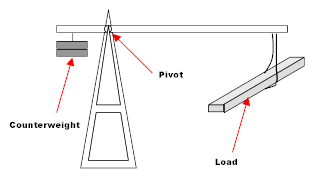Crane design is a complex process that requires careful consideration of various factors, including the use of counterweights. Counterweights play a crucial role in maintaining the stability and balance of cranes, allowing them to lift heavy loads safely. This article explores the science behind counterweights in crane design, highlighting their importance and how they are calculated and implemented.
Understanding the Role of Counterweights in Crane Design
Counterweights play a crucial role in crane design, providing stability and balance to the machine. These weights are strategically placed to counteract the weight of the load being lifted, preventing the crane from tipping over. By distributing the weight evenly, counterweights ensure that the crane remains stable and can safely lift heavy loads. The size and placement of the counterweights are carefully calculated to ensure optimal balance and prevent any potential accidents. Without counterweights, cranes would be unable to safely lift heavy objects, making them an essential component in crane design.
The Physics Behind Counterweights: How They Balance Crane Loads

Counterweights are an essential component in cranes that help balance the loads being lifted. The physics behind counterweights lies in the principle of torque and equilibrium. Torque is the rotational force that is applied to an object, and equilibrium is the state in which all forces acting on an object are balanced. In cranes, the counterweight is positioned on the opposite side of the load being lifted, creating a torque that counteracts the torque created by the load. This ensures that the crane remains stable and does not tip over. The counterweight is carefully calculated and adjusted to match the weight of the load, allowing for safe and efficient lifting operations.
The Importance of Proper Counterweight Placement in Crane Stability
Proper counterweight placement is crucial for maintaining crane stability and ensuring safe operations. Counterweights are used to balance the weight of the load being lifted, preventing the crane from tipping over. The placement of counterweights must be carefully calculated to distribute the weight evenly and counteract the force exerted by the load. If counterweights are not properly positioned, the crane may become unbalanced, leading to accidents and potential damage to the crane and surrounding structures. Crane operators must have a thorough understanding of the crane’s load capacity and the importance of counterweight placement to ensure safe and efficient lifting operations.
Innovations in Counterweight Technology: Enhancing Crane Performance
Innovations in counterweight technology have greatly enhanced crane performance in recent years. Counterweights are an essential component of cranes as they provide stability and balance to the machine. Traditionally, counterweights were made of solid materials such as concrete or steel, which limited their adjustability and efficiency. However, advancements in technology have led to the development of innovative counterweight systems that offer improved performance and versatility. These new systems utilize modular counterweights that can be easily adjusted and reconfigured to meet the specific requirements of each lifting operation. This allows for greater flexibility and efficiency in crane operations, resulting in increased productivity and safety. Overall, these innovations in counterweight technology have revolutionized the crane industry and continue to drive advancements in crane performance.
Factors to Consider in Determining the Ideal Counterweight for a Crane
When determining the ideal counterweight for a crane, there are several factors that need to be considered. Firstly, the weight of the load being lifted is crucial. The counterweight should be heavy enough to balance the load and prevent the crane from tipping over. Additionally, the distance the load will be lifted and the boom length of the crane are important factors. Longer booms and higher lifting distances require larger counterweights to maintain stability. The type of terrain and weather conditions also play a role in determining the ideal counterweight. Uneven or soft ground may require a heavier counterweight for stability, while strong winds may necessitate additional counterweight to prevent the crane from swaying. Overall, a careful analysis of these factors is essential to ensure the safe and efficient operation of a crane.
The Future of Counterweights in Crane Design: Advancements and Trends
In recent years, there have been significant advancements and trends in the design of counterweights for cranes. Traditionally, counterweights have been used to balance the load being lifted by a crane, ensuring stability and preventing tipping. However, with the development of new technologies and materials, the future of counterweights is evolving. One major trend is the use of lightweight materials, such as composite materials and high-strength alloys, which allow for the reduction of overall weight without compromising strength and stability. Additionally, advancements in computer-aided design (CAD) and simulation software have enabled engineers to optimize counterweight placement and design, resulting in more efficient and effective crane operation. Overall, the future of counterweights in crane design is promising, with continued advancements and innovations expected to enhance safety and performance in the industry.
Conclusion
In conclusion, the science of counterweights plays a crucial role in crane design, ensuring stability and safety during lifting operations. By carefully calculating the weight and position of counterweights, engineers can effectively counterbalance the load being lifted, preventing the crane from tipping over. This knowledge and understanding of counterweights are essential for the efficient and successful operation of cranes in various industries.
What is a counterweight in crane design?
A counterweight is a heavy weight that is used to balance the load being lifted by a crane. It is typically located at the opposite end of the crane’s boom or jib.
Why are counterweights used in crane design?
Counterweights are used in crane design to prevent the crane from tipping over when lifting heavy loads. By placing a counterweight on the opposite end of the load, the crane’s center of gravity is balanced, ensuring stability.
How are counterweights selected for crane design?
The selection of counterweights for crane design depends on various factors, including the maximum load capacity of the crane, the length of the boom or jib, and the desired stability. Engineers use mathematical calculations and simulations to determine the appropriate weight and placement of counterweights.
What materials are used for counterweights in crane design?
Counterweights in crane design are typically made from dense materials such as steel, concrete, or cast iron. These materials provide the necessary weight and stability required to balance the crane’s load.
Can counterweights be adjusted in crane design?
Yes, counterweights in crane design can be adjusted to accommodate different load capacities and boom lengths. This allows for flexibility in crane operations and ensures optimal stability for each lifting task.
Are counterweights used in all types of cranes?
No, counterweights are not used in all types of cranes. The need for counterweights depends on the design and purpose of the crane. Some cranes, such as tower cranes, may have built-in counterweights, while others, like mobile cranes, may require additional counterweights to be attached.

